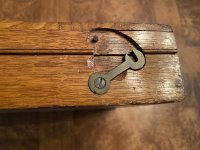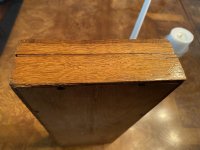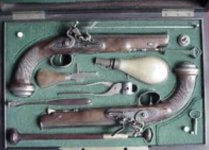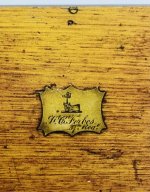Several others appeared in a recent thread that addressed cased Smith & Wesson revolvers.
In Post #5 of the following thread, BMur refers to this as a London case:
http://smith-wessonforum.com/s-w-antiques/700415-model-91-first-model-single-shot-pistol.html
Any ideas as to the composition of the disc? My guess is it’s bronze.
And can anyone produce a disc that is engraved with initials, or anything else, for that matter? I’ve never seen one that is engraved. But what other purpose would this disc serve, unless purely decorative?
Being located in the lid, it does lend itself to being engraved. On the other hand, being a disc, it doesn’t lend itself well to being engraved as far as composition/layout, as would a more rectangular inset, unless one engraved a larger centrally located initial flanked by smaller ones on either side.
Also, the surface of the disc is atypical of an inset as far as finish, independent of the composition and shape of the disc. Most insets were highly polished and independent of any tooling marks. Every one of these discs shows clear evidence of having been turned on a lathe. Being this disc is so atypical of anything else from the era, 1840 to 1905, it was a red herring and led me to the initial conclusion that the case containing my British proofed pistol from 1905 was neither British nor period.
Photographs attached to this thread illustrate what I am writing more.
Other red herrings that initially led me to believe this case was not British and dating from 1840 to 1905 are the following:
1. Joinery. Simple 45 degree angles. I would have expected it to be dovetailed.
2. The latches. Being mitered out to fit the latch is atypical of any other latch I have seen before. Others are not inset into the case, but are above the surface of the case. The lack of a highly or even reasonably finished (meaning sanded and smoothed) surface in the mitered area led me to initially conclude this work was likely subsequent to the time of manufacture of this case.
In Post #5 of the following thread, BMur refers to this as a London case:
http://smith-wessonforum.com/s-w-antiques/700415-model-91-first-model-single-shot-pistol.html
Any ideas as to the composition of the disc? My guess is it’s bronze.
And can anyone produce a disc that is engraved with initials, or anything else, for that matter? I’ve never seen one that is engraved. But what other purpose would this disc serve, unless purely decorative?
Being located in the lid, it does lend itself to being engraved. On the other hand, being a disc, it doesn’t lend itself well to being engraved as far as composition/layout, as would a more rectangular inset, unless one engraved a larger centrally located initial flanked by smaller ones on either side.
Also, the surface of the disc is atypical of an inset as far as finish, independent of the composition and shape of the disc. Most insets were highly polished and independent of any tooling marks. Every one of these discs shows clear evidence of having been turned on a lathe. Being this disc is so atypical of anything else from the era, 1840 to 1905, it was a red herring and led me to the initial conclusion that the case containing my British proofed pistol from 1905 was neither British nor period.
Photographs attached to this thread illustrate what I am writing more.
Other red herrings that initially led me to believe this case was not British and dating from 1840 to 1905 are the following:
1. Joinery. Simple 45 degree angles. I would have expected it to be dovetailed.
2. The latches. Being mitered out to fit the latch is atypical of any other latch I have seen before. Others are not inset into the case, but are above the surface of the case. The lack of a highly or even reasonably finished (meaning sanded and smoothed) surface in the mitered area led me to initially conclude this work was likely subsequent to the time of manufacture of this case.





























